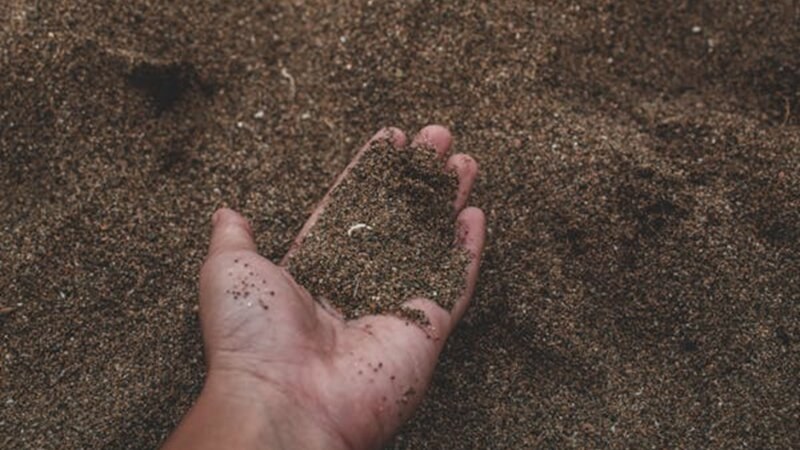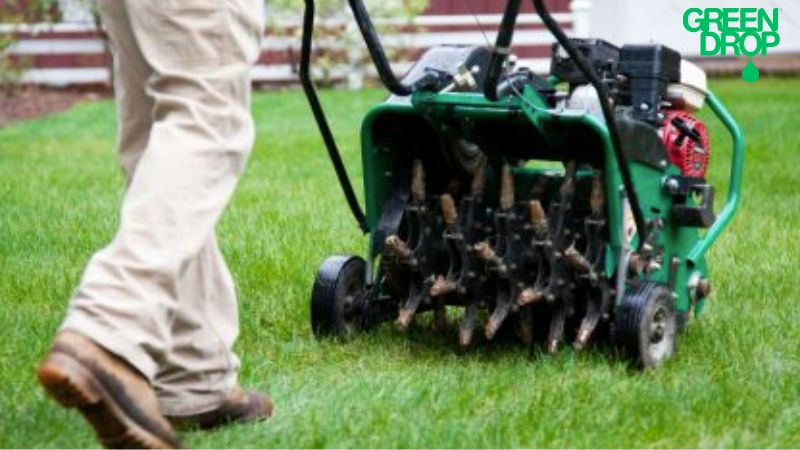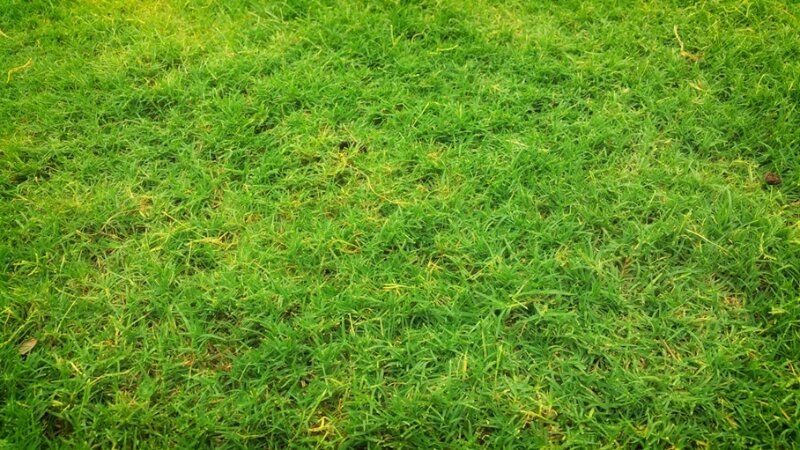Your Local AB GreenKeepers Speaks! The Science Behind Lawn Aeration & How It Benefits Soil Health
Reading time: 6 minutesAerating your lawn is important to keeping your soil and grass healthy, but how does it work? Explore the science behind lawn aeration and how it benefits soil health. Plus, learn how Green Drop can help you maintain a beautiful lawn without breaking your budget.

Lawn Aeration 101
Over time, the grass naturally dies because your lawn’s soil becomes compacted. Aeration and overseeding are key processes that help relieve soil compaction and establish new grass on top of your existing lawn. This allows water and nutrients to flow deep into the soil where your grass is rooted and fills in “bald” spots where lawn areas have completed their life cycle.
Top Benefits of Aerating Your Soil
Aerating your soil is a key component of good lawn care and has many benefits, like:
- Enhanced Nutrient Absorption: Aeration loosens compacted soil, allowing essential nutrients to reach the grass roots more effectively.
- Improved Water Infiltration: It prevents water runoff and ensures water reaches deep into the root zone, improving water retention.
- Reduced Thatch Buildup: Aeration helps break down thatch, the layer of dead grass and debris that can stifle lawn growth.
- Stimulates Root Growth: Aeration encourages roots to grow deeper, creating space in the soil and a stronger lawn.
- Increases Drought Resistance: A well-aerated lawn utilizes water more efficiently, making it more resilient during dry conditions.
- Improves Soil Structure: Removing soil cores during aeration helps reduce soil compaction and promote healthy grass growth.
- Enhances Seed Germination: Overseeding in conjunction with aeration can help new grass seeds germinate more effectively.
- Helps in Pest and Disease Management: A healthy lawn with good aeration is less susceptible to pests and diseases.
- Boosts Overall Lawn Health: Aeration improves the conditions for grass growth, contributing to a vibrant, lush lawn.
- Optimizes Fertilizer Uptake: Fertilizers are more effective on aerated lawns as they can reach the root zone where they're most needed.
These are just a handful of the advantages of aerating your grass, and you can expect many more when you incorporate aeration and overseeding into your annual lawn maintenance strategy.

How to Know If You Need Aeration and Overseeding
Aerating your lawn is a beneficial practice that will drastically improve soil health and the appearance of your lawn. That said, some lawns need aeration more than others and are likely to have ongoing problems until soil compaction is relieved and oxygen, water, and nutrients can reach the root system.
Signs your lawn is due for an aeration:
- Your lawn gets heavy foot traffic. People running, walking, and playing on your lawn push soil down on top of itself and reduce the amount of space between dirt particles, eventually leading to compaction.
- Your grass was initially installed as sod. Sod may be a great way to get green grass fast, but it also causes soil layering. This causes a natural barrier to form in between each layer of soil, which water and sunlight have a harder time passing through. Over time, your lawn’s root system becomes matted and can no longer transport nutrients.
- Your home was recently constructed. New construction is tough on soil and often strips the nutrient-rich top layer away before sod is laid or grass seed is planted. This essentially only leaves compacted subsoil for the grass to root in, which provides little sustenance for your lawn.
- Your grass is springy and dry. If your grass is dry and "springs" back when you step on it, it could result from thatch build-up between your lawn's root system and the soil underneath. Thatch can also get compacted, which makes it even more difficult for water to get through. When this happens, you might notice water pooling in the middle of your lawn when it rains or when you water the grass.
In each scenario, aeration gets to the root of the problem, so to speak, and gives your lawn a fresh start. When you overseed after aerating, your grass will look greener, fuller, and healthier all season long! Yay!

When to Aerate for Best Results
Lawn aeration is best done in the spring or fall in Western Canada. If you haven’t aerated by the middle of September for fall, it’s best to wait until the next, or you risk freezing out newly sprouted grass.
Aerating in the fall helps it prepare for the winter by allowing natural root expansion, giving it room to strengthen and spread. As temperatures drop, your grass isn’t fighting the battle of retaining water and protecting itself from the blistering heatwaves.
In the spring, your cutoff for the biggest beneficial impact is around June. Any longer than that, and your new grass may not be able to survive the warmer weather that comes with the heat of the summer months.
Answering Your Questions About Lawn and Soil Health

How do I know if my grass is healthy?
Key signs of grass health include its colour, the presence of weeds, how well the soil drains, and pest infestations. Healthy grass will be thick and green, with few weeds and pests. You won't see puddling after it rains, either.
Grass that’s too long can start to thin, so it's important to keep your lawn mowed to a height of about 2 to 3 inches. Any closer, and you risk scalping your lawn, especially if you just aerated and overseeded.
What are the major components of healthy soil?
There are five basic components of healthy soil: oxygen, water, organic matter, living organisms, and minerals. The average ratio of each component in the soil sample is about 45% minerals, 20–30% water, 20–30% oxygen, and 5% organic matter.
Minerals typically found include a mixture of nitrogen, phosphorus, potassium, manganese, sulphur, calcium, and carbon. Different soil types have different ratios of each of these minerals, so it’s important to select the right kind of topsoil or fertilizer for your lawn. An experienced lawn care specialist can help make sure your soil has the correct minerals in the proper amount for healthy soil and grass growth.
Do I need to have my soil tested?
Testing your soil is the only sure way to know if it’s healthy. While there are visual signs that your soil is good quality, like being moist and loamy, this isn’t enough to determine if your lawn has the right amount of minerals and organic matter.
It’s best to test your soil in the early fall, ideally before aerating and overseeding your lawn.
What will a soil test tell me?
When you have your soil tested, you will receive a data profile of your soil’s:
- pH. This lets you know how alkaline or acidic your soil is. Neutral soil is best, as it has a pH between 6 and 7.5.
- Texture. Your soil will be classed as either silt, sand, loam, or clay. It can also be a mixture of these and may be identified as sandy loam, loamy sand, silt loam, sandy clay loam, silty clay loam, clay loam, silty clay, or sandy clay.
- Nutrients. This tells you how much nitrogen, potassium, phosphorus, and other critical nutrients there are in your soil sample.
- Organic matter. Good soil typically has about 3–6% organic matter.
Helping Your Alberta Lawn Look Healthy & Feel Great
At Green Drop, we love lush lawns and take lawn health seriously. That’s because we know what it takes to keep your lawn looking great—spring, summer, and fall (we let your lawn rest in the winter). When you need someone you can trust to take the hassle of lawn care off your shoulders, our team of experts is just a call away.
Here are our lawn care packages to choose from. Our recommendation? The Beautiful Premium package is where your lawn gets everything it needs to look lush and spectacular!
We provide lawn aeration and overseeding services in Alberta (Calgary, Edmonton, and Red Deer) and surrounding areas in Western Canada, including Regina, Saskatoon, and Winnipeg. Let’s talk soon!

